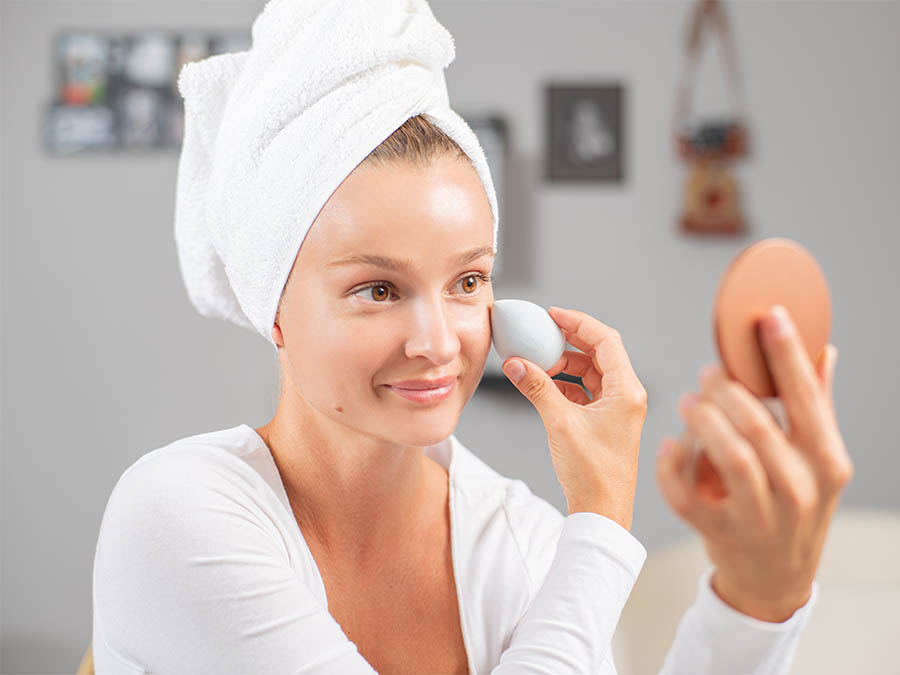6 Simple Steps How To Apply Foundation This Winter
Winter brings about a change in our skincare and makeup routines. As the temperature drops, our skin tends to become drier and more sensitive.
Applying foundation during winter requires a different approach compared to other seasons to achieve a flawless and hydrating look.
Here at Fashion.ie, we’ll walk you through the steps to apply foundation during the winter months to ensure your skin remains radiant and protected from the harsh elements.
Make Sure to Choose the Right Foundation for Your Skin
Choosing the right makeup foundation is essential for achieving a flawless look. Here are some factors to consider when looking for a good makeup foundation/
1. Skin Type
Consider your skin type when choosing a foundation. There are foundations designed for different skin types, including oily, dry, combination, and sensitive skin. Look for a foundation that matches your skin type to ensure it doesn’t exacerbate any skin issues.
2. Shade Matching
The foundation shade should closely match your natural skin tone. Test the foundation on your jawline or wrist to find a shade that blends seamlessly with your skin. Natural lighting is best for colour matching.
3. Undertone
Pay attention to your skin’s undertone, which can be warm (yellow or golden), cool (pink or blue), or neutral (a mix of both). Choose a foundation with the appropriate undertone to enhance your complexion.
4. Coverage
Decide on the level of coverage you need. Foundations come in various finishes, including sheer, light, medium, and full coverage. Sheer foundations provide a more natural look, while full coverage foundations can conceal blemishes and imperfections.
5. Formula
Consider the formula of the foundation. Common options include liquid, cream, powder, and stick foundations. Choose a formula that suits your preferences and skin type. Liquid foundations are versatile and work well for most skin types.
6. Finish
Foundations can have different finishes, such as matte, satin, dewy, or radiant. The finish you choose should align with your skin type and desired look. Matte finishes are ideal for oily skin, while dewy finishes add a healthy glow to dry skin.
7. Longevity
If you need your makeup to last throughout the day or night, look for long-wear or waterproof foundations. These formulas are designed to stay in place and resist transfer.
8. Ingredients
Check the ingredients list for any potential allergens or irritants, especially if you have sensitive skin. Avoid foundations with ingredients that may clog pores or cause breakouts.
9. SPF Protection
Some foundations contain sun protection (SPF). While it’s an added bonus, it shouldn’t be your sole source of sun protection. Consider using a dedicated sunscreen underneath your foundation for adequate UV protection.
10. Brand and Reviews
Research brands known for their quality foundations and read product reviews. Customer reviews can provide insights into how well a foundation performs and whether it suits your needs.
11. Application Method
Consider how you prefer to apply foundation, whether with a brush, sponge, or your fingers. Some foundations work better with specific application methods.
12. Price
Foundations come in a wide price range. While expensive options may offer unique features or luxury packaging, there are also many affordable options that perform exceptionally well. Choose one that fits your budget.
13. Allergies and Sensitivities
If you have allergies or sensitivities to certain ingredients, make sure to check the foundation’s ingredient list for potential triggers.
It’s a good idea to visit a makeup counter or store where you can receive professional assistance in shade matching and testing different foundations to find the one that suits you best.
Additionally, consider wearing the foundation for a few hours to see how it holds up and if it causes any adverse reactions before making a final decision.
How To Apply Foundation This Winter
Now you understand all the key elements of choosing the right foundation for your skin this winter, let’s take a look at the application process.
Step 1: Prepping Your Skin
Before you even think about applying foundation, it’s crucial to prepare your skin. Winter air can be dehydrating, so a good skincare routine is essential. Follow these steps:
- Cleansing: Start by cleansing your face with a gentle, hydrating cleanser to remove any dirt and makeup residue.
- Exfoliation (Optional): Use a mild exfoliant to slough away dead skin cells, but don’t overdo it. Once or twice a week is enough during winter.
- Moisturise: Apply a rich, hydrating moisturizer to lock in moisture. Look for products with ingredients like hyaluronic acid, shea butter, or ceramides.
- Primer (Optional): If you have large pores or uneven skin texture, apply a hydrating primer to create a smooth canvas for your foundation.
Step 2: Choosing the Right Foundation
Selecting the right foundation for winter is crucial. Opt for a product that provides both coverage and hydration. Consider these factors.
- Formulation: Liquid or cream foundations tend to work best during winter as they offer more moisture and a dewy finish.
- Shade Match: Ensure your foundation shade matches your winter skin tone. Your summer shade may not be suitable, as your skin can become lighter during the winter months.
- Ingredients: Look for foundations with added skincare benefits like hyaluronic acid, glycerine, or vitamins to keep your skin hydrated.
Step 3: Applying Foundation
Now that your skin is prepped and you’ve chosen the right foundation, let’s move on to the application process.
- Dispense a small amount of foundation onto the back of your hand or a makeup palette.
- Use a makeup brush, makeup sponge, or clean fingers to apply the foundation.
- Start from the centre of your face and blend outwards. Be gentle to avoid irritating your winter skin.
- Pay attention to problem areas, like redness or blemishes, and build coverage as needed.
- Blend well into your jawline and neck to avoid any noticeable lines.
Step 4: Concealing and Highlighting
During winter, it’s common to have some redness or dry patches. Use concealer to target these areas:
- Apply a creamy, hydrating concealer slightly lighter than your foundation shade to areas like under your eyes, around your nose, and on any blemishes.
- Blend the concealer using a makeup sponge or your fingertip, ensuring it seamlessly blends with your foundation.
- If you want to add a subtle winter glow, use a liquid highlighter on the high points of your face, like your cheekbones and brow bone.
Setting Your Foundation
To prevent your foundation from budging and to maintain that fresh look, set it with a setting powder.
- Choose a loose or translucent setting powder to avoid a matte finish that can accentuate dryness.
- Use a fluffy brush to apply the powder lightly over your T-zone and any areas prone to oiliness.
- Avoid over-powdering, as this can make your skin appear dry.
Step 6: Final Touches
Finish off your winter foundation routine with these final touches.
- Add a pop of colour to your cheeks with a hydrating cream blush or a sheer powder blush.
- Define your eyes with eyeshadow, eyeliner, and mascara as desired.
- Complete your look with a winter-appropriate lip colour, like a moisturizing lipstick or tinted lip balm.
And Finally
Applying foundation during winter requires extra care to maintain a radiant and hydrated complexion.
By following these steps and choosing the right products, you can achieve a flawless winter glow that lasts all day while protecting your skin from the harsh elements.
Remember, a well-prepped canvas is the key to a flawless makeup application, so prioritize your skincare routine as well. Enjoy your winter beauty transformation!






